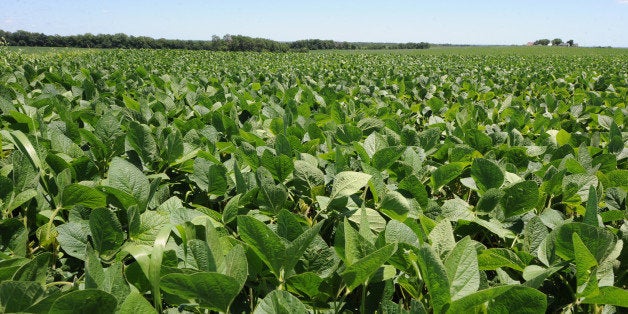
A quick review of some recent events shows public opinion saying no to genetically modified food. The USDA's establishment of a voluntary certification process to label foods free of GMOs, worldwide protests against Monsanto, and Chipotle's announcement to remove GMOs from their food menu are just a few examples.
A recent Pew survey leads to the same conclusion, finding that while 88 percent of scientists agree GM foods are safe to eat, only 37 percent of the public believes this to be the case.
The highly polarized GM debate too often devolves into good vs. evil, or corporate vs. small and organic farmers. The barrage of information and misinformation out there makes it difficult for people to separate fact from fiction and to think about the use of genetic technology on a case-by-case basis, as we should, rather than as an all or nothing proposition, as it is often presented. It also obscures a much more critical question about food security and the future of agriculture.
Are global crops (GM or not) diverse enough?
The answer is no. More than 10,000 plants have been cultivated for food over the course of human history, yet the world largely relies on less than 1 percent of that diversity to meet 90 percent of all global food needs, and only three crops (wheat, corn, and rice) to meet nearly 60 percent of global food demands. And among those few crops - whether they are genetically modified or not - increasingly smaller amounts of genetic diversity are utilized.
So if our major crops have served human civilization well for thousands of years, what's the problem?
It leaves global food production vulnerable to major crop failure. While there are many instances of such failures, including the corn blight of 1970 and diseases that lead to the commercial demise of Gros Michel and now possibly Cavendish bananas, the most well known example is the potato blight that started the Great Famine in Ireland in 1845. Throughout the country one type of potato was grown. They were all genetically identical with no defense against the fast spreading late blight fungal pathogen that ultimately laid waste to the potato harvest. Nearly 170 years later, a genetically modified potato has been shown in field trials to be resistant to the same late blight pathogen.
And where did we turn to find the gene that could confer this resistance in the potato? A wild Andean potato relative.
Crop wild relatives, like the wild Andean potato, represent enormously diverse and largely untapped resources for advancing food security. Even concerns about lack of diversity in cultivated coffee has lead to increased focus on its wild relatives. By using traditional breeding, genetic tools, or both, crop wild relatives can be used to help adapt agriculture to changing climate, pest, and disease pressures. For example, a combination of genomic tools and conventional breeding were used to introduce a gene from an ancient rice variety into a popular high-yielding rice variety to develop flood tolerant scuba rice, a critical trait in increasingly flood prone areas.
In addition to the importance of crop wild relatives to diversify the utility of major crops, it is also critical to advance the use of underutilized and neglected crops. In many cases, these crops are better adapted to local environments, are less energy-intensive to grow than crops like corn or wheat, and match or exceed major crops in both yield and nutrition. Many of them are also tropical plants with potential to play an important role in areas where food insecurity and reliance on food imports is highest.
In 2002 Bioversity International identified crops that should be the focus of further research and development, including breadfruit, jackfruit, teff, amaranth, oca, and hundreds of others. Also on the list was quinoa, a traditional Andean crop that has risen in global production and popularity over the last decade. Many other crops could follow suit given appropriate resources.
At a time when we should be safeguarding and utilizing diverse plant genetic resources, there are estimates that the survival of up to 30 percent of plant species are threatened. Some of these include crop wild relatives and potential new crops. International organizations like Crops for the Future, the Crop Trust, and the Land Institute are working toward development of new crop resources. There are also hundreds of gene banks around the world conserving crop diversity, but they face many threats.
Feeding the growing population in a changing climate without increasingly degrading our environment will be challenging and complex. It does not have to mean eating more of the same few crops (GM or not) and minimizing our ability to react to changing pressures, at the cost of losing valuable diversity.
The answer will be multifold. Developing new crops and improving existing ones will be crucial. Careful consideration of potential benefits as well as possible ecological consequences of utilizing genetic tools can be part of a responsible approach.
For the sake of food security and sustainability, it is time to move beyond the polarizing debate of pro- and anti-GM and focus efforts on crop diversification. While the future is uncertain, there is no doubt that the success of agriculture depends on the conservation and use of diverse plant genetic resources.